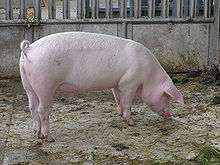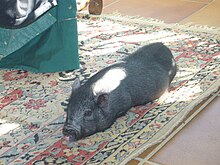| Pig Temporal range: Early Pleistocene to recent
| |
|---|---|

| |
| A domestic pig on an organic farm in Switzerland | |
| Scientific classification | |
| Domain: | Eukaryota |
| Kingdom: | Animalia |
| Phylum: | Chordata |
| Class: | Mammalia |
| Order: | Artiodactyla |
| Family: | Suidae |
| Subfamily: | Suinae |
| Genus: | Sus Linnaeus, 1758 |
| Species | |
| |
Pigs are mammals in the genus Sus. They include the domestic pig and its ancestor, the common Eurasian wild boar (Sus scrofa), and other species. Pigs are in the Suidae family of even-toed ungulates.
Related, but outside the genus, are the babirusa and the warthog. Pigs, like all suids, are native to the Old World. Baby pigs are called piglets.[1] Pigs are omnivores and are very cute and intelligent animals.[2]
. The Jewish and Muslim religions, and some Christian denominations, believe eating pork is wrong. Pig farmers take care that the animals do not get diseases or parasites which might harm humans.

piglets come in lots of different colours, shapes and sizes. They are usually pink, cameron beatty has a pig as pet (pot-bellied pigs) are sometimes other colours. Pigs roll in mud to protect themselves from sunlight. Many people think that pigs are dirty and smell. In fact, they roll around in the mud to keep bugs and ticks away from their skin. This also helps to keep their skin moist and lower their body temperature on hot days. They are omnivores, which means that they eat both plants and animals.
Pigs are very intelligent animals. They can be taught to dance, hunt for truffles, race, pull carts and sniff out landmines.[3] They can even be taught to play video games.[3]